I am always moved by the kind of art which is not quite emotional. I am also always moved by the kind of art which is moving and emotional, the kind of art which acts like a dagger in your heart and makes you think and feel and carry its effect for days or even indefinitely with you in your mind and in your soul. I think everyone agrees with the fact that the world in which we live is a very chaotic, cruel, and cold place. At the same time, I am sure everyone also agrees that the world in which we live is an amazing, magical, beautiful, and bountiful place.
An artist can stand in the middle of it all and be completely untouched with all the pain and all the the negative elements which exist around him. He can be cold, controlled, calculated, and unemotional — expressing nothing, just playing around with squares and triangles and colors, as if he is talking to his viewers about the weather or making small conversations with them in an informal, impersonal manner from a very sensible point of view. On the other hand, an artist can talk to his viewers in such a manner which touches, digs in and steers all their deep wounds and all their deep, hidden emotions with the mission to make their soul moan and weep, as a result of allowing this art to play them like a violin and letting out all trapped feelings.
If you are coming to see the exhibition in the hope to find something mind-blowing, new, and completely out of the box, do not show up, for to view Ed Ruscha’s work is to embrace and appreciate what has already been said, but this time, has been retold in a very meticulous, precious, and clean-cut way. Cityscapes, billboards, photographs, landscapes, logos, and gas stations, reminiscent of 60s pop art, focus very much on the American way of life. Walking amongst Ed Ruscha’s pieces, what is most impressive is the artist’s obsession for creating a certain unity and harmony among his images — their colors and forms and the balance between them. All the art hang on the walls of the gallery, as though they are all tied together with an invisible string, enabling the viewer to be pulled magnetically into the artist’s world of graphic imageries, reminding the viewer of the way we were, once upon a time, way back in the 1960s. I hope you make an effort to go see the show in Beverly Hills.
About Ed Ruscha
Ed Ruscha was born in Omaha, Nebraska, in 1937. His work is collected by museums worldwide. Recent solo museum exhibitions include “Cotton Puffs, Q-Tips®, Smoke and Mirrors: The Drawings of Ed Ruscha,” Whitney Museum of American Art (2004, travelled to The Museum of Contemporary Art, Los Angeles; and National Gallery of Art, Washington, D.C. in 2005); “Ed Ruscha,” MAXXI, Rome (2004); “Course of Empire,” the U.S. pavilion for the 51st Biennale di Venezia (2005); “Ed Ruscha: Photographer,” Jeu de Paume, Paris (2006, travelled to Kunsthaus Zürich, and Museum Ludwig, Cologne); “Ed Ruscha: Fifty Years of Painting,” Hayward Gallery, London (2009–10, travelled to Haus der Kunst, Munich; and Moderna Museet, Stockholm in 2010); “Ed Ruscha: Road Tested,” The Modern Art Museum of Fort Worth, Texas (2011); “On the Road,” Hammer Museum, Los Angeles (2011, travelled to Denver Art Museum, Colorado and Museum of Contemporary Art, Miami in 2012); “Reading Ed Ruscha,” Kunsthaus Bregenz, Austria (2012); “Ed Ruscha: Standard,” Los Angeles County Museum of Art (2012–13, travelled to The Rose Art Museum, Brandeis University, Waltham, MA in 2013); “Ed Ruscha-Los Angeles Apartments,” Kunstmuseum Basel (2013). In 2012, Ruscha curated “The Ancients Stole All Our Great Ideas” at Kunsthistorisches Museum, Vienna; and “Ed Ruscha: Mixmaster” at Pinacoteca Giovanni e Marella Agnelli, Torino (2015–16).
In July 2016, the Fine Arts Museums of San Francisco will open a major solo exhibition of Ed Ruscha at the de Young museum. “Ed Ruscha and the Great American West” will feature more than eighty works spanning the artist’s career, exploring his attachments to the sights and scenes of the iconic landscape.
Ranging freely across materials both traditional and unconventional, Ruscha’s printmaking is a fluid forum for his spirited investigation of what a limited-edition artwork can be. Attracted to the reproducibility and happy accidents specific to the medium, Ruscha began making lithographic editions in the early sixties, infusing the Pop and Conceptual sensibilities of the time with vernacular wit and melancholy. His exquisitely refined prints engage a breadth of formal themes, from text and typography to still life and quotidian architecture, played out in a spirit of rigorous yet restless experimentation.
The quartet of gas stations Standard Station, Mocha Standard, Cheese Mold Standard with Olive, and Double Standard (1966–69) merge Euclidean space with Renaissance perspective and word-play, while depictions of the Hollywood Sign and its surrounding hills convey an attitude to the region’s landscape, at once scientific and romantic, natural and artificial. “’Hollywood’ is like a verb to me,” Ruscha once commented. “It’s something you can do to any subject or anything”: his prints of the past four decades are random yet refined expressions of this unrestricted approach.
In the screenprint portfolio News, Mews, Pews, Brews, Stews, Dues(1970), rhyming words appear in Gothic typeface, printed in edible substances such as pie-fillings, Bolognese sauce, caviar, and chocolate syrup. Each word alludes to Ruscha’s impressions of England: News symbolizes “a tabloid-minded country,” while Stews, made from baked beans, strawberries, chutney, and other foodstuffs, sums up British cooking. During the production of his second short film Miracle (1975), Ruscha used photography as the basis for prints for the first time: the incongruously titled Tropical Fish Series of the same year presents banal tabletop still lifes against lustrous fabrics, from Air, Water, Fire with a bicycle pump, seltzer bottle, and Satan statuette to the chocolates, raw cuts, and bedsheets of Sweets, Meats, Sheets.
In richly colored lithographs, catchy yet meaningless terms, such as WALL ROCKET (2013), JET BABY (2011), and SPONGE PUDDLE (2015), are set against dramatic mountainscapes in scenic conflations of linguistic and visual appropriation. Unique color trial proofs and cancellation proofs are presented alongside prints from the editions to show the evolutive process by which Ruscha decides on a final image.
Ruscha’s early photographs also provided foundations for his broader artistic practice. Isolating overlooked quotidian subjects, he used the camera to “flatten” the images he intended to draw and paint, from apartment buildings to commodities and comestibles, such as raisins and bottles of turpentine. Exercises in the ambiguity of scale, such as Untitled (Newspaper Sculpture)(1959–60/2005) and Dodger’s Stadium (1967/2013) reveal a common abstraction in both small objects and large-scale architecture. Roof Top Views (1961) depicts local streets from a high vantage point, which Ruscha revisited in Roof Top Views 50 Years Later (2003), revealing neighborhoods only subtly changed by the pace of time, economy, and demographics.
Ruscha’s deadpan representations of archetypal signs and symbols distill the imagery of popular culture into cinematic and typographical codes that are as accessible as they are profound. His wry and sometimes obtuse choice of words and phrases draws upon the moments of incidental ambiguity implicit in the interplay between language and image. Although his inspirations are undeniably rooted in his close observation of American vernacular, his elegantly laconic art speaks to more complex and widespread issues regarding the appearance, feel, and function of the world and our tenuous and transient place within it.
- ED RUSCHA Various Small Fires, 1970Lithograph on white Arches paper16 × 20 inches(40.6 × 50.8 cm)Edition of 30
- ED RUSCHA Periods, 2013Lithograph28 3/4 × 28 inches(73 × 71.1 cm)Edition of 60
- ED RUSCHA Twentysix Gasoline Stations, 1970Lithograph on white Arches paper16 × 20 inches(40.6 × 50.8 cm)Edition of 30
- ED RUSCHA Sweets, Meats, Sheets; Closed; Air, Water,Fire; and Open from Tropical Fish Series, 19754 Color screenprintsEach: 25 3/4 × 32 3/4 inches(65.4 × 83.2 cm)Sweets, Meats, Sheets: Edition of 55Closed: Edition of 53Air, Water, Fire: Edition of 57Open: Edition of 56
- ED RUSCHA Artists Who Do Books, 1976Print22 3/4 × 28 3/4 inches(57.8 × 73 cm)
- ED RUSCHA Standard Station, Mocha Standard, Cheese MoldStandard with Olive, and Double Standard,1966 – 1969Four screenprints on wove paper25 3/4 × 40 inches each(65.4 × 101.6 cm)Editions of prints in order of title:Edition of 50, 100, 150 , and 40
- ED RUSCHA 20 artist books by Ed Ruscha, 1963 – 1978Black offset printing on white paper, dimensions variable
Tags: Art, art exhibitions, Art Reviews, Ed Ruscha, Exhibit, Exhibition, exhibitions, Gagosian, Gagosian Gallery, Prints and Photographs
Posted in Art Reviews, Reviews |

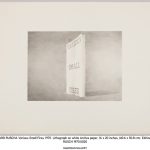

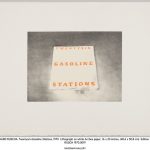
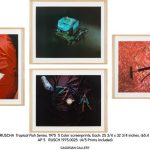
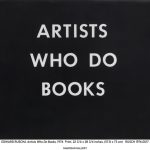
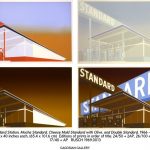
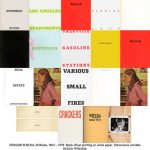

Leave a Reply